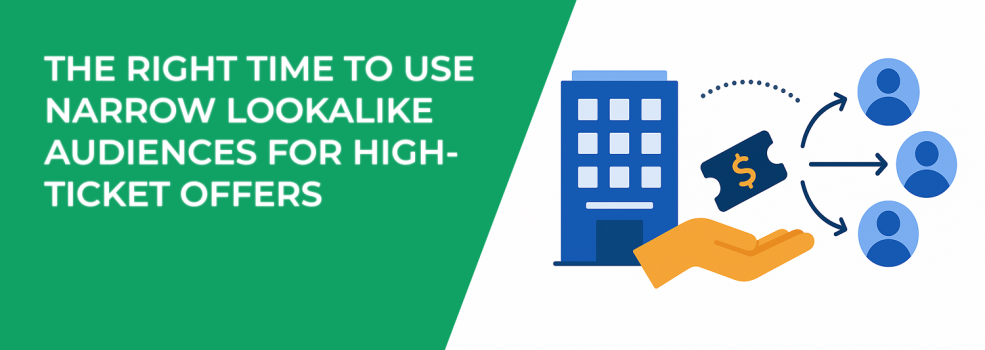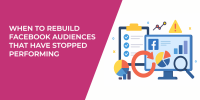Not all lookalike audiences are created equal. Especially when you're trying to sell something expensive.
If you’re running Facebook ads for high-ticket products or services, broad strategies can quickly eat up your budget with little to show for it. That’s why narrowing your lookalike targeting isn’t just a tactic — it can be a turning point.
Let’s break down why narrow lookalikes work, when they actually outperform broader ones, and how to use them effectively without tanking your reach.
Why High-Ticket Offers Need a Tighter Focus
When you're selling a $2,000 course, a $5,000 service, or a luxury item, you’re not just asking for a click — you’re asking for trust, commitment, and a serious financial decision.
In this context, relevance matters more than reach.
Broad lookalikes based on vague sources (like all website visitors or people who watched 3 seconds of a video) might work well for cheaper products. But for high-ticket offers, they often attract the wrong people — curious browsers, freebie seekers, or casual scrollers. The kind of audience that burns your ad budget without delivering sales.
That’s where narrow lookalike audiences shine. Built from high-intent behaviors, they’re more precise. They don’t just look like your audience — they act like your best customers.
If you’re still defining which audiences belong in your funnel, this breakdown of Facebook ads audiences offers a solid foundation.
So, When Is the Right Time to Use Narrow Lookalikes?
Not every campaign or ad account is ready for tight targeting. But if you’re seeing any of the following scenarios, switching to narrow lookalikes might be the upgrade your ads need.
1. Your Lead Quality Is Low
Maybe you’re getting plenty of leads, but your sales team is spending time on calls that go nowhere. If you're collecting contact info but not interest — or worse, not even engagement — it’s a sign you’re casting too wide a net. Narrowing your lookalikes can help you prioritize users who act more like your actual customers.
2. You Have Solid First-Party Data
Lookalike audiences only work as well as the source you build them from. If you’ve collected 100–500 high-value actions (like purchases or qualified applications), you’re in a great position to build a narrow 1% audience with real conversion potential.
Not sure how to identify your strongest segments? Our guide to finding high-intent audiences using Facebook Insights explains how to pinpoint exactly who’s worth modeling.
3. You’re Scaling Past Retargeting
Retargeting is powerful, but it only lasts so long. When you’ve hit the ceiling with warm audiences, narrow lookalikes give you access to cold traffic that’s far more likely to convert — without relying on interest targeting alone.
4. You're Running an Application Funnel or Discovery Call Offer
If your conversion event involves time or trust — like a consultation or application — then quality matters even more. Broad lookalikes often lead to poor bookings, low show-up rates, or unqualified leads. A narrower approach gives Meta clearer signals to target people who are more likely to follow through.
Tips for Building Narrow Lookalike Audiences That Actually Perform
If you want to make the most of narrow lookalikes, you’ll need more than just a checkbox in Ads Manager. You need to be deliberate with your setup.
Here’s what to prioritize:
-
Use the highest-quality source possible. Go beyond clicks and basic leads. Focus on purchase events, scheduled calls, or leads that made it past a qualifying step. That depth gives the algorithm better patterns to model.
-
Keep the percentage narrow (1% to 2%). Don’t rush to expand. With high-ticket offers, it's usually better to stay close to your source — even if that means fewer impressions.
-
Segment by offer, product, or lifecycle stage. If you sell multiple programs or services, don’t mix all buyers into one audience. Build separate lookalikes based on what users purchased or signed up for, so you can tailor the messaging.
-
Refresh your audience frequently. Over time, even the best audiences lose relevance. Refresh your source every few weeks to ensure your lookalike data reflects your most recent (and most aligned) customers.
For a deeper look at how to avoid common audience-building errors, this piece on top mistakes marketers make with lookalikes is a must-read.
Common Mistakes That Sabotage Narrow Lookalikes
It’s not enough to choose a narrow percentage and hope for the best. Many advertisers set up narrow lookalikes only to see weak performance — not because the idea is flawed, but because the execution is.
Avoid these mistakes:
-
Relying on weak source events like “add to cart.”
-
Using budgets too small for Meta to optimize properly.
-
Serving generic ads to a highly specific audience.
-
Mixing warm and cold behaviors into one source group.
And if your lookalike audiences just aren’t converting the way they should, it might be time to step back and troubleshoot. Here’s how to recognize the red flags in this guide on why lookalikes underperform.
Final Thoughts: Bigger Isn't Always Better
Selling a high-ticket offer demands more from your ads — more clarity, more trust, and more alignment with user behavior.
Narrow lookalike audiences give you precision without abandoning scale. They help you reach people who already act like your ideal customers, instead of wasting budget on the curious but uncommitted.
So before you expand, ask yourself: is your campaign designed to get more clicks — or more conversions?

